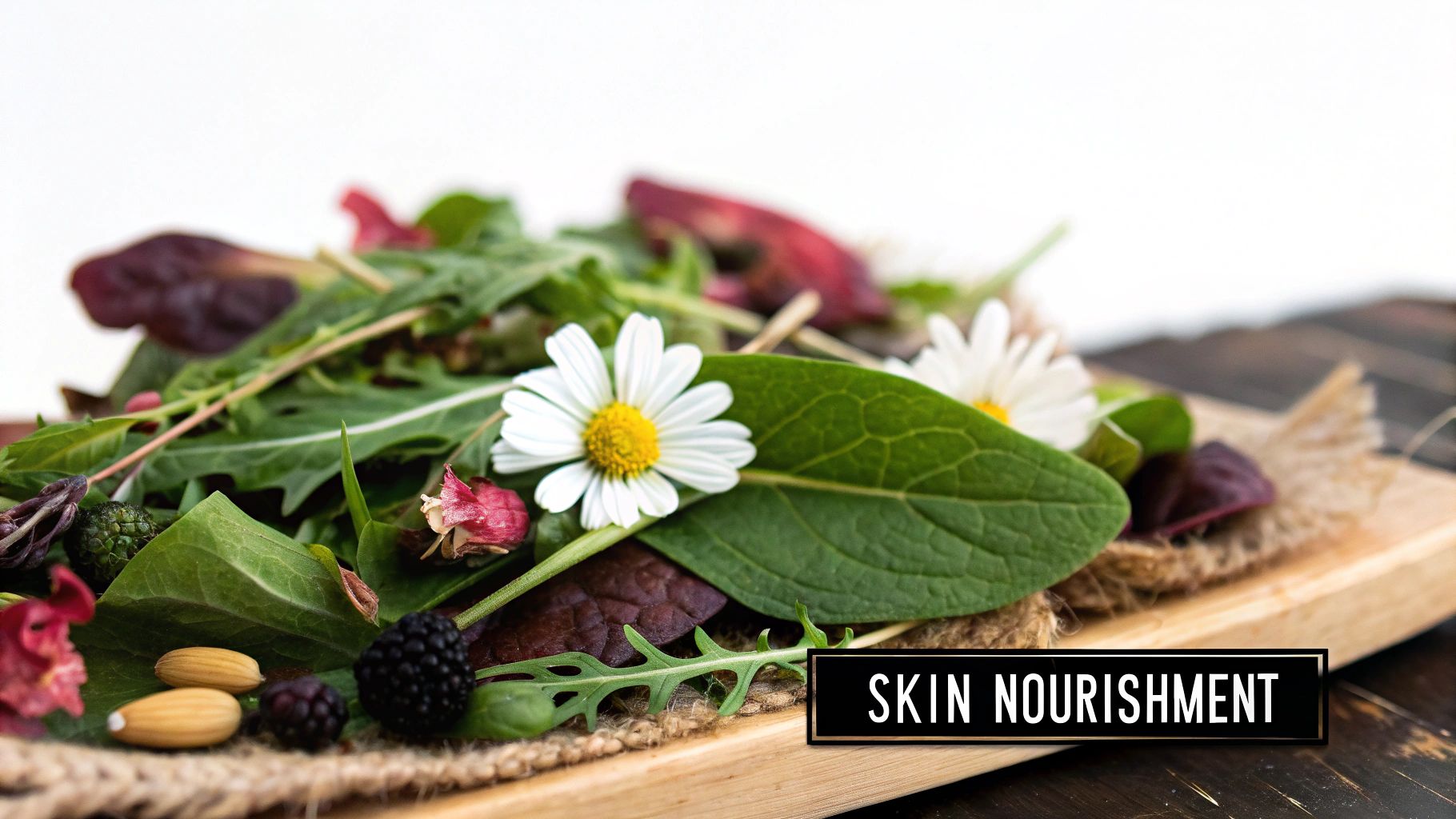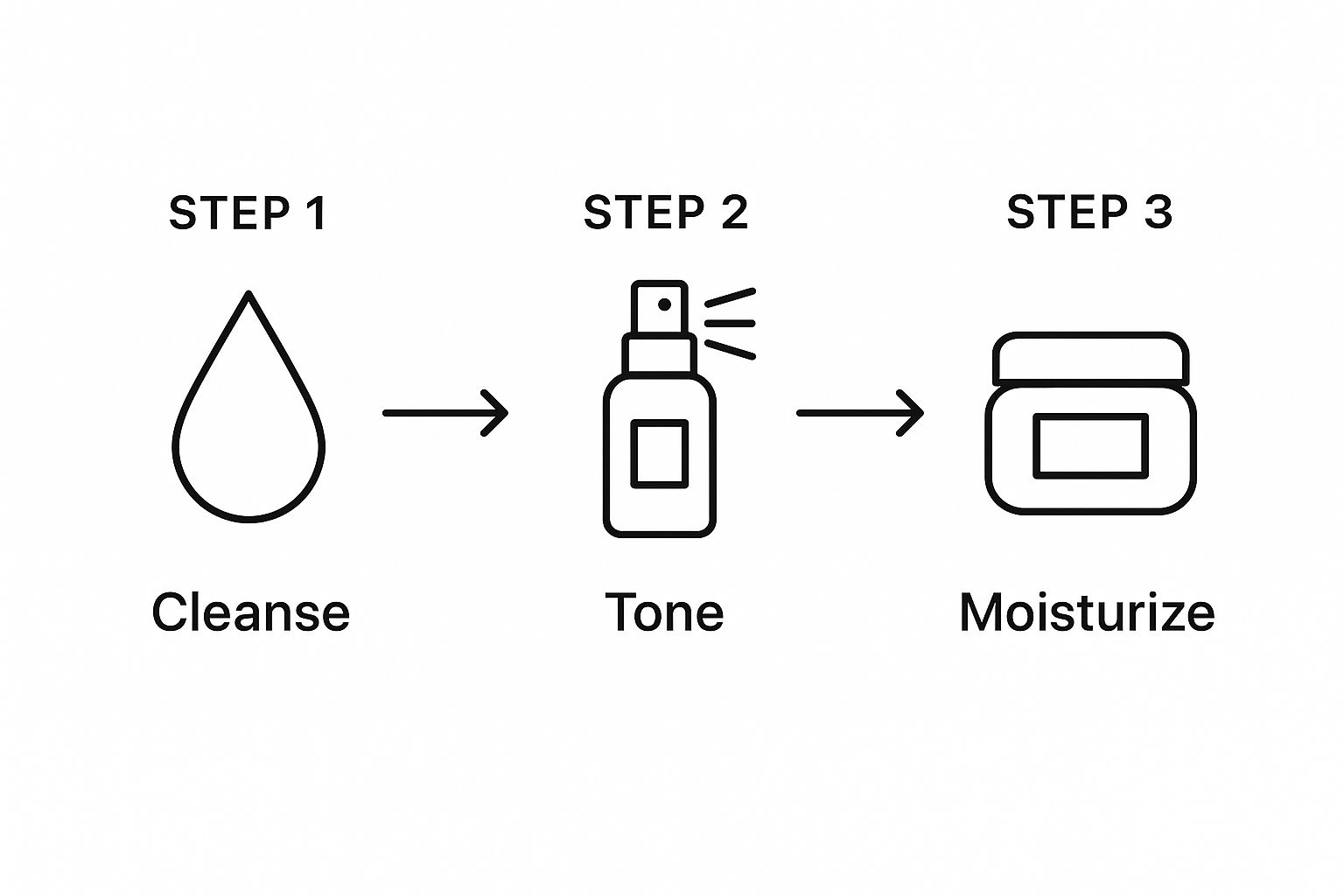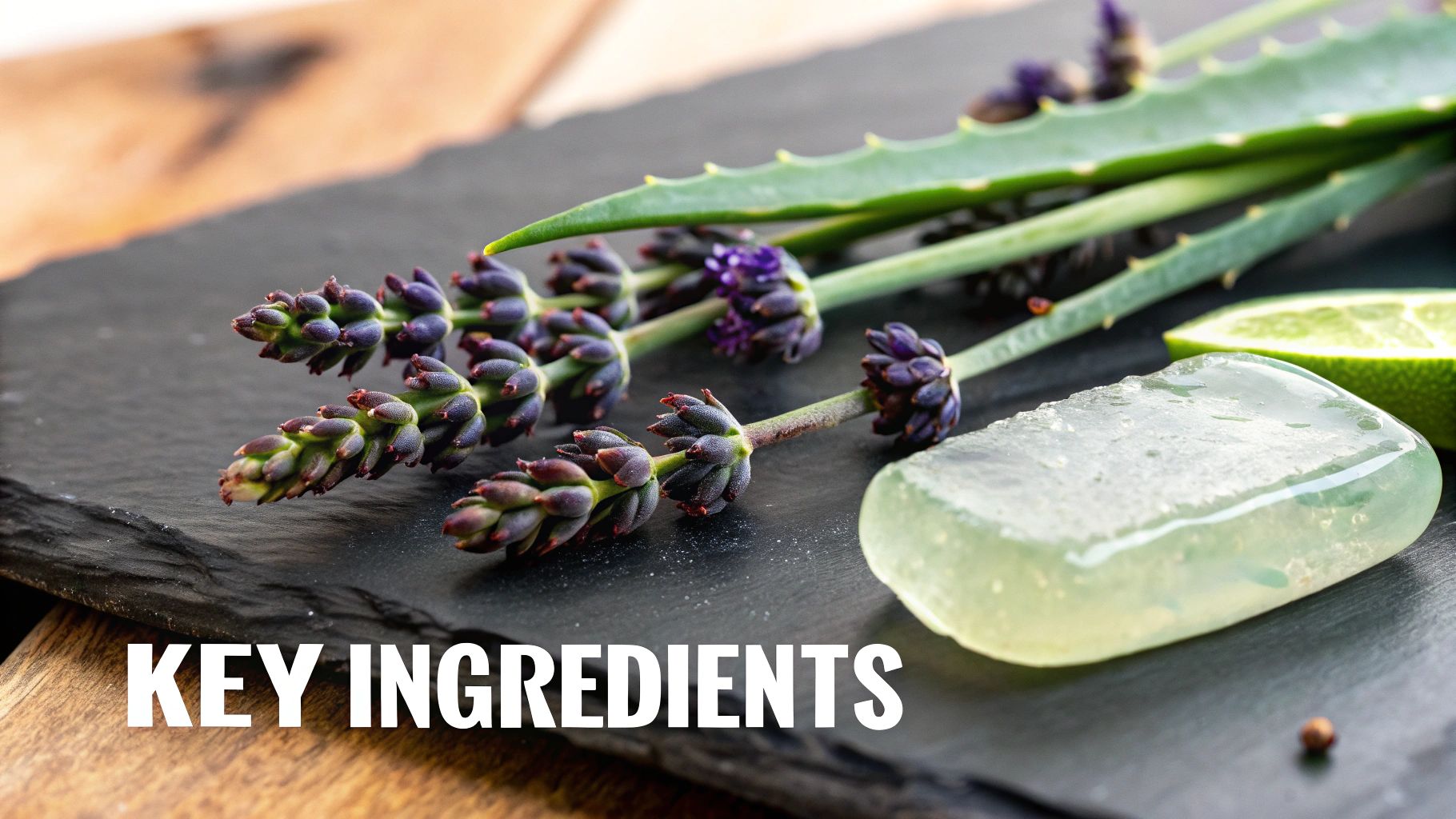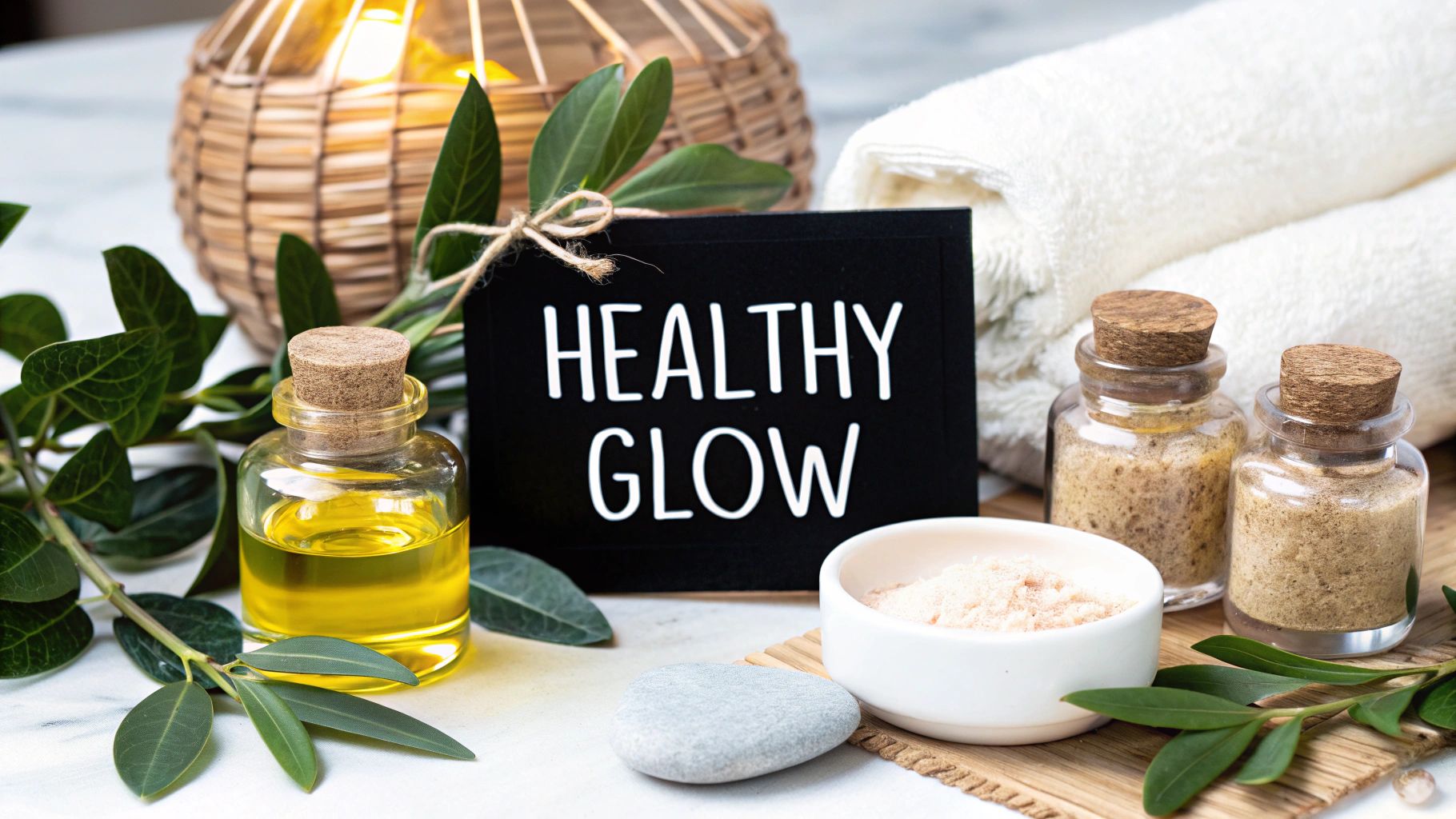When we talk about natural skin care, we're discussing formulations that primarily use ingredients derived from nature—things like plant-based oils, rich minerals, and botanical extracts. The goal is to nourish the skin with recognizable ingredients while being mindful of certain synthetic chemicals like parabens, sulphates, and artificial fragrances, which some people prefer to avoid.
What Are Natural Skin Care Products?
The phrase "natural skin care" often conjures up images of fresh botanicals and pure, simple formulas. At its core, this approach is about using ingredients sourced directly from nature—think soothing plant oils, vibrant fruit extracts, and essential minerals—to support your skin’s health. It’s like feeding your skin the same kind of wholesome, nutritious ingredients you'd want to eat.
This isn’t just a fleeting trend; it’s a conscious shift toward being more aware of what we put on our skin. Instead of relying solely on complex, lab-created chemicals, natural skin care taps into the inherent power of botanical ingredients that have been used for centuries and are now being studied for their dermatological benefits.
Clarifying Key Terms
Stepping into the world of natural beauty can feel a bit confusing at first. You’ll see a lot of terms thrown around, and while they might seem similar, they have important distinctions. Getting a handle on these definitions is the first step to making truly informed choices.
- Natural: This term generally means that ingredients are derived from natural sources. However, because "natural" is not a strictly regulated term in the cosmetics industry, it's important to read the full ingredient list to understand a product's composition.
- Organic: This is a regulated term. For a product to have an official organic seal, it must contain a high percentage of ingredients grown without the use of synthetic pesticides, fertilizers, or GMOs, according to specific government standards.
- Clean: This is a marketing term, not a regulated one, focused on safety and transparency. Clean beauty products are formulated without a specific list of ingredients that some consumers find controversial, regardless of whether those ingredients are natural or synthetic.
The move toward these products is more than just a feeling; the numbers back it up. The demand for organic personal care, a huge driver of the natural skin care movement, is booming. Globally, this market is projected to climb from USD 23.35 billion in 2024 to USD 25.74 billion in 2025. That's a massive consumer shift toward cleaner formulas. You can explore more about this trend and what's behind it on The Business Research Company.
The core idea is simple: nourish your skin with ingredients from nature while avoiding certain synthetic chemicals. This sets the foundation for a healthier, more balanced approach to skin care.
Choosing natural skin care is about more than just what you’re avoiding—it’s about what you are intentionally putting on your skin. When you select products packed with vitamins, antioxidants, and essential fatty acids from plant-based sources, you’re giving your skin the fundamental building blocks it needs to function at its best, look radiant, and feel genuinely healthy.
The Science Behind Natural Ingredients

When we talk about natural skincare, it's not just about what you're leaving out; it’s about what you’re putting in. A common misconception is that "natural" means less effective. The reality is that many botanically-derived ingredients are backed by scientific research, proving they can make a real difference in how your skin looks and feels.
To get the most out of your products, you need to understand what these ingredients actually do. Think of it like building a team of specialists for your skin—each one has a specific job. Let's dig into the science behind three key groups: Hydrators, Antioxidants, and Soothers.
The Hydrators: Quenching Your Skin's Thirst
Proper hydration is the absolute foundation of healthy, glowing skin. When your skin is dehydrated, it can look dull, feel tight, and even make fine lines appear more pronounced. Natural hydrators are fantastic at tackling this by either drawing moisture into the skin (humectants) or creating a barrier to prevent moisture loss (occlusives).
One of the most well-known humectants is hyaluronic acid. This substance is naturally present in our skin and connective tissues. Its superpower is its incredible ability to hold up to 1,000 times its own weight in water. By binding moisture to the skin, it helps plump up its appearance, giving you that dewy, supple look.
Then there's glycerin, a plant-derived workhorse that acts as another highly effective humectant, drawing hydration into the skin to keep it soft and comfortable all day long.
The Antioxidants: Your Skin’s Bodyguards
Every single day, your skin faces an onslaught from environmental stressors like UV rays and pollution. These factors generate unstable molecules called free radicals, which cause oxidative stress that can damage collagen and accelerate the visible signs of aging.
Antioxidants are like a personal security detail for your skin cells. They work to neutralize these free radicals before they can cause lasting damage, helping to protect your skin's strength and vitality.
Vitamin C is arguably the most famous antioxidant, and for good reason. Not only does it fight free radicals, but it's also essential for collagen synthesis—the process that keeps skin firm. As a bonus, it can help inhibit melanin production, which may help fade dark spots and even out your skin tone over time.
Here are a few other powerful antioxidants to look for:
- Vitamin E (Tocopherol): A great team player, it often works synergistically with Vitamin C to enhance its protective capabilities.
- Green Tea Extract: Rich in polyphenols, it’s brilliant for its antioxidant and soothing properties, which can help calm irritation.
- Resveratrol: Found in the skin of grapes and berries, this potent ingredient helps defend your skin against environmental aggressors.
The Soothers: Calming Inflammation and Irritation
Inflammation is your body's normal response to injury, but when it becomes a chronic, low-level issue, it can manifest as redness, sensitivity, and a compromised skin barrier. Natural soothing ingredients are fantastic for calming the skin and helping it return to a balanced state.
Chamomile is a classic soother. It contains compounds like bisabolol, which are scientifically recognized for their impressive anti-inflammatory properties, making it perfect for calming down fussy, irritated skin.
Likewise, colloidal oatmeal is so effective at relieving itchiness and irritation that it's recognized by health authorities as a skin protectant. It creates a soft film over the skin that locks in moisture and helps buffer against irritants.
To show how these ingredients come together in real products, we've put together a quick guide to some of the most effective natural components.
Key Natural Ingredients and Their Skin Benefits
This table breaks down some of the most powerful natural ingredients you'll find, explaining what they do and where you're likely to see them.
| Ingredient | Primary Benefit | How It Works | Found In |
|---|---|---|---|
| Hyaluronic Acid | Deep Hydration | Holds up to 1000x its weight in water, plumping skin. | Serums, Moisturizers |
| Vitamin C | Brightening & Protecting | Neutralizes free radicals and is a cofactor for collagen production. | Serums, Treatments |
| Green Tea Extract | Anti-inflammatory & Antioxidant | Calms redness and protects against environmental stress. | Cleansers, Toners |
| Chamomile | Soothing | Contains bisabolol to reduce inflammation and calm irritation. | Creams, Masks |
| Colloidal Oatmeal | Barrier Support & Relief | Forms a protective layer to lock in moisture and soothe itching. | Cleansers, Lotions |
| Vitamin E | Nourishing & Protecting | A fat-soluble antioxidant that moisturizes and fights free radicals. | Oils, Creams |
Ancient remedies often tap into these same principles. For instance, the long-standing use of rice water for skin highlights how time-tested ingredients are rich in vitamins and minerals that nourish and calm the skin.
Once you understand the science, it's clear that natural ingredients aren't just a "gentle" option—they're targeted, powerful solutions. By thinking in terms of what your skin needs—be it hydration, protection, or calming—you can build a truly effective routine rooted in the power of nature.
The Real Benefits of Using Natural Skin Care

Making the switch to natural skin care isn't just about hopping on a new trend. It's a thoughtful choice to use ingredients that can be both gentle on the surface and powerful underneath. The upsides go far beyond what you see in the mirror, positively affecting your skin's health, your overall sense of well-being, and even the planet.
When you move away from products with ingredients that don't suit your skin, you can often see a real, tangible difference. Some conventional cleansers and creams rely on things like sulphates. While effective at cleaning, they can also strip your skin of its natural oils and disrupt its delicate moisture barrier, which can sometimes be the culprit behind frustrating irritation, redness, and sensitivity.
Natural alternatives often take a much gentler approach. They use plant-derived ingredients that work in harmony with your skin. This helps preserve your skin’s vital protective barrier, leading to a calmer, more comfortable complexion that’s less prone to reactivity.
Superior Nourishment From Nature
Think of natural ingredients as a superfood smoothie for your skin. While some synthetic ingredients are designed to perform a single function, like moisturizing, they can't always replicate the complex, nutrient-rich profile found in botanicals. Plant-based oils, butters, and extracts are brimming with vitamins, antioxidants, and essential fatty acids that support skin health.
A good botanical oil, for instance, does so much more than just hydrate. It delivers a whole spectrum of nutrients that help protect, repair, and rejuvenate your skin cells from the inside out. This holistic nourishment is a huge reason why so many people notice a visible improvement in their skin's texture and radiance when they use well-formulated natural products.
If you want to dig a little deeper, exploring the benefits of choosing natural ingredients can really highlight why a nature-first philosophy is so effective for long-term skin health.
Long-Term Health and Wellness
The advantages of a thoughtful routine also touch on your long-term well-being. Our skin is our largest organ, and it’s porous, meaning it can absorb small amounts of what we apply to it. While cosmetic ingredients are used in concentrations deemed safe by regulatory bodies, some people prefer to minimize their cumulative exposure to certain synthetic chemicals over their lifetime.
Opting for well-formulated natural products helps lighten this "chemical load," which offers incredible peace of mind. Instead of wondering about certain ingredients, you're actively nourishing your body with biocompatible elements that support its functions.
This shift is a proactive step toward a cleaner lifestyle, aligning your personal care routine with your broader wellness goals. It's about nurturing your body from the outside in, just as you do from the inside out.
A targeted serum is a fantastic way to deliver a concentrated dose of this botanical goodness. For example, a high-quality rosehip oil serum is a powerhouse of antioxidants and fatty acids that brightens and hydrates—all without unnecessary fillers.
A Kinder Choice For The Planet
The positive ripple effect of choosing mindfully-produced skin care extends well beyond your own bathroom. The entire clean beauty movement is built on a foundation of sustainability, from how ingredients are grown and harvested to how the final products are packaged.
Many conscientious brands are deeply committed to:
- Sustainable Sourcing: Harvesting ingredients in ways that protect the environment and support local communities.
- Biodegradable Formulas: Creating products that break down safely without polluting our waterways.
- Eco-Friendly Packaging: Using materials that are recyclable, already recycled, or even compostable to cut down on waste.
This commitment to the planet is a major reason why the demand for mindfully-made beauty continues to grow. When you choose brands with these values, you're not just buying a product; you're casting a vote for a healthier, more sustainable future.
How to Build Your First Natural Skin Care Routine
Let's be honest, starting a new skincare routine can feel like a huge commitment. With so many products and "must-do" steps, it's easy to get overwhelmed. But building an effective, natural routine is actually much simpler than you think. The secret is to focus on a few key steps that work together to keep your skin clean, nourished, and protected.
Think of it like cooking a simple, delicious meal. You start by washing your ingredients (cleanse), add your star player with all the nutrients (treat), and then seal it all in with a protective sauce (moisturize and protect). Each step has a purpose, building on the last to create something truly satisfying.
The Foundational Steps of a Natural Routine
A great routine isn't about having a shelf full of a dozen different bottles. It’s about consistency and using products with purpose. It really boils down to four essential pillars that form the backbone of healthy skin. Once you’ve mastered these, you can always get more creative, but these are the non-negotiables for getting started.
- Cleanse: Gently remove dirt, oil, and impurities without stripping your skin.
- Treat: Deliver a concentrated dose of active ingredients to target your specific concerns.
- Moisturize: Hydrate your skin and lock in that moisture to support its natural barrier.
- Protect: Shield your skin from daily environmental damage, especially the sun's UV rays.
When you understand these pillars, you can choose your products wisely, making sure every item in your routine is working hard for you.
This simple graphic breaks down the essential flow of a daily routine, showing how each step logically follows the next.

As you can see, a straightforward, three-step approach—Cleanse, Tone, and Moisturize—is the core framework for both your morning and evening skincare.
Step 1: Cleanse Gently
Cleansing is your routine's essential starting point. It clears away the daily grime, makeup, and excess oil, creating a perfectly clean slate for all the wonderful products you’re about to apply. The problem is that many conventional cleansers use harsh sulphates that can strip away your skin's natural oils, leaving it feeling tight, dry, and irritated.
Natural cleansers, on the other hand, use gentler, plant-derived surfactants or nourishing oils to clean just as effectively without disrupting your skin’s delicate balance. For a beautifully gentle yet thorough clean, a product like the Pure Heart Essentials Skincare Cleanser is a perfect example, using natural ingredients to purify the skin.
Pro Tip: If you wear makeup or sunscreen (and you should!), try the double-cleansing method. First, use an oil-based cleanser to melt away the makeup and SPF. Then, follow up with a gentle water-based or cream cleanser to wash everything clean away.
Step 2: Treat Specific Concerns
This is where you get to play and really customize your routine. Treatment products, like serums, are lightweight powerhouses. They're formulated with a high concentration of active ingredients designed to address specific issues like fine lines, dark spots, or blemishes.
For example, a serum packed with Vitamin C is fantastic for brightening your complexion and giving you antioxidant protection during the day. In the evening, you might switch to a serum with bakuchiol—a wonderful plant-based ingredient that studies show has retinol-like effects—to encourage skin renewal while you sleep. The key is to always apply these treatments to clean skin, right before your moisturizer, so they can sink in and get to work.
Step 3: Moisturize and Hydrate
Moisturizing is absolutely vital for every single skin type—yes, even if you have oily skin! A quality natural moisturizer does two very important jobs: it hydrates by drawing water into the skin, and it locks that moisture in by reinforcing your skin’s protective barrier.
Keep an eye out for hydrating heroes like hyaluronic acid and glycerin, along with nourishing plant butters like shea or cocoa. These ingredients help keep your skin feeling plump, smooth, and resilient. A lighter lotion might be all you need for daytime, while a richer, more decadent cream can provide deeper nourishment overnight.
Step 4: Protect Your Progress
If there's one step you never, ever skip, it's this one. Sunscreen is arguably the most important part of any skincare routine. It’s your daily defense against UV radiation, which is the primary driver of premature aging and skin cancer. Without this final, crucial step, all the benefits from your other products can be undermined by the sun.
For a natural routine, mineral sunscreens are a fantastic choice. They use zinc oxide and titanium dioxide to create a physical shield that sits on top of your skin and reflects UV rays away. People with sensitive skin often prefer them because they are generally less likely to cause irritation.
Tailoring the Routine to Your Skin Type
The best part about a natural routine is how easily you can adapt it. The four core steps always stay the same, but the specific products you choose should be tailored to what your skin is telling you it needs.
- For Oily or Acne-Prone Skin: Look for lightweight, non-comedogenic formulas that won't clog pores. A weekly clay mask can help absorb excess oil, and a toner with witch hazel can help clarify.
- For Dry Skin: Your focus should be on rich, nourishing ingredients. Creamy cleansers, hydrating serums with hyaluronic acid, and moisturizers loaded with plant oils and butters will be your best friends.
- For Combination Skin: Try a "zoning" approach. You might use a clarifying cleanser all over but only apply a richer moisturizer to your drier spots, like your cheeks.
- For Sensitive Skin: Prioritize products with short, calming ingredient lists. Look for formulas that are free from fragrance and feature soothing ingredients like chamomile, colloidal oatmeal, or aloe vera.
By starting with this simple framework and really listening to your skin, you can build a natural skincare routine that feels good and delivers real, lasting results.
How to Read Labels and Choose Quality Products

Trying to find truly natural skin care products can feel a bit like learning a new language. With so many brands making big promises, how do you sort the genuinely great stuff from the clever marketing? The secret is learning to read the labels.
Think of a product label as its ingredient list. It tells you everything you need to know about what’s really inside, but only if you know what you’re looking for. This skill is your best defence against "greenwashing"—a tactic where companies use earthy-sounding words to make their products seem more natural than they actually are.
The good news? It’s easier than you might think. Once you know what to look for (and what to sidestep), you’ll feel much more confident in choosing products that genuinely care for your skin.
Read the Ingredient List Like a Pro
The single most telling part of any label is the ingredient list, which you'll often see marked as "INCI" (International Nomenclature of Cosmetic Ingredients). There's one golden rule here: ingredients are always listed from the highest concentration to the lowest.
This means the first five or six ingredients are what make up most of the product. If you see things like water, aloe vera, or a beautiful botanical oil at the top, that’s a fantastic sign. On the other hand, if the first few ingredients are chemicals you can't pronounce and the "natural" extracts are buried at the bottom, the product probably isn't as pure as it claims to be.
A truly nourishing product like the Genesis Tallow Face & Tallow Whip, for example, proudly lists its key, high-quality ingredients right up front. That’s how you know you're getting a potent, effective formula.
Spot Meaningful Certifications
Think of third-party certifications as a trusted reference check. They prove that an outside organization has verified a brand's claims, giving you an extra layer of peace of mind.
Keep an eye out for these well-respected logos:
- USDA Organic: This is a tough standard to meet. It ensures at least 95% of the ingredients are certified organic, meaning they were grown without synthetic pesticides or fertilizers.
- Ecocert: A globally recognized seal for organic and natural cosmetics. Ecocert looks at everything from the raw materials all the way to the finished product and even its packaging.
- Leaping Bunny (Cruelty-Free): This logo is your guarantee that no animal testing happened at any point in the product’s development.
The growing demand for these transparent products is clear. The natural personal care market is booming, and it's driven by health-conscious people who want safer, more transparent options for their families.
Common "Red Flag" Ingredients to Avoid
Choosing quality natural products isn't just about what's in them—it's also about what's not in them. While everyone's skin has different sensitivities, certain synthetic ingredients are consistently flagged by clean beauty experts as being ones some consumers wish to avoid.
Being aware of common "red flags" helps you make more informed decisions about what you put on your body every day.
Here’s a quick list of ingredients you might want to steer clear of:
| Ingredient | Why It's a Concern for Some |
|---|---|
| Parabens | Used as preservatives; there is ongoing debate about their potential to act as endocrine disruptors. |
| Phthalates | Often hidden under "fragrance," these are used to make scents last longer. Some research has linked them to endocrine disruption. |
| Sulphates (SLS/SLES) | These create the foamy lather in cleansers but can be harsh, potentially stripping the skin's natural oils and leading to dryness and irritation. |
| Synthetic Fragrance | This vague term can conceal dozens of unlisted chemicals, which are very common culprits behind skin allergies and sensitivities. |
Learning to spot these on a label is a huge step toward making better choices for your skin. For a fantastic deep dive into what makes products truly safe and effective, this non-toxic skincare guide is an excellent resource to build your confidence and knowledge.
Answering Your Top Natural Skincare Questions
Making the leap into natural skin care can feel a little like venturing into a new world. You're probably wondering about a few things—do these products actually work? What's this "purging" I keep hearing about? It's completely normal to have questions, and getting straight answers is the best way to feel great about making a change.
Let’s clear up some of the confusion and bust a few myths. My goal here is to give you honest, practical answers so you can navigate your journey to cleaner beauty with total confidence.
Are Natural Products as Effective as Synthetic Ones?
This is the big one, isn't it? And the answer is a clear and simple yes, they can be. A product’s efficacy comes from its formulation and the active ingredients it contains, not whether it's labeled "natural" or "synthetic." Many of the most effective, evidence-backed ingredients in skincare come directly from nature.
For example, bakuchiol, a plant-based ingredient, has been shown in studies to provide results comparable to retinol for smoothing fine lines, often without the associated irritation. We also have extensive scientific research backing the antioxidant power of Vitamin C from sources like acerola cherry, and the deep, plumping hydration from plant-derived hyaluronic acid. The secret is finding well-formulated products that use these botanicals in meaningful concentrations.
Will My Skin "Purge" When I Switch?
The term "skin purging" is a specific reaction that can happen when you introduce an active ingredient that accelerates skin cell turnover, like an alpha-hydroxy acid (AHA) or retinoid. This process can push underlying congestion to the surface, causing a temporary breakout in your usual problem areas. This type of breakout should resolve relatively quickly as your skin adjusts.
Simply swapping your old moisturizer for a new natural one shouldn't cause a true purge. If you experience breakouts in new places, prolonged redness, or itching, it's more likely a sign of irritation or an allergic reaction to a specific ingredient. This is why it's always wise to patch-test any new product on a small, discreet area first.
Key Takeaway: A "purge" is a specific, short-term reaction to active exfoliants. Widespread or prolonged irritation is your skin telling you a product isn't the right match.
Do Natural Products Expire Faster?
Because natural products often use alternative preservatives instead of synthetic ones like parabens, they can sometimes have a shorter shelf life. However, modern natural skincare is formulated by cosmetic chemists to be both safe and stable for its intended use period. Always look for the "Period After Opening" (PAO) symbol on the packaging. It looks like a little open jar with a number like "6M" or "12M," telling you exactly how many months the product is good for after you open it.
To maintain your products' integrity, a few simple habits go a long way:
- Store them in a cool, dark place (your bathroom cabinet is perfect; the steamy shower ledge is not).
- Always use clean hands or a spatula to dispense the product.
- Make sure you twist those lids on tight to keep air and bacteria out.
Is "All-Natural" Always Better or Safer?
While nature provides an abundance of gentle and powerful ingredients, the term "natural" is not automatically synonymous with "safe for everyone." Poison ivy is 100% natural, but you wouldn't want it in your face cream! Some people have allergies or sensitivities to certain essential oils or plant extracts, just as others might react to synthetic ingredients.
A product's safety is determined by its complete formulation, the concentration of its ingredients, and whether it's appropriate for your specific skin type and concerns. For example, exfoliating products need to be carefully balanced to be effective without causing irritation. For a smart and convenient approach, consider pre-soaked pads like the Bushbalm Radiant Reset Exfoliating Toner Pads, which take the guesswork out of application. Ultimately, the most important rule is to listen to your skin.
Ready to build a routine that feels as good as it looks? At Opal Wellness Pharmacy, we've curated a selection of the finest natural and clean skin care products to help you achieve your healthiest, most radiant skin. Explore our collection and find your new favourites today.
Discover Your Perfect Natural Skin Care Routine at Opal Wellness Pharmacy
Article created using Outrank

